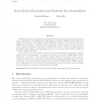CRYPTO
2007
Springer
15 years 1 months ago
2007
Springer
We put forward a new paradigm for building hybrid encryption schemes from constrained chosen-ciphertext secure (CCCA) key-encapsulation mechanisms (KEMs) plus authenticated symmet...
CISC
2007
Springer
15 years 1 months ago
2007
Springer
Abstract. Key privacy is a notion regarding the privacy of the owner of a public key, which has important applications in building (receiver) anonymous channels, or privacy-enhance...
AFRICACRYPT
2008
Springer
15 years 1 months ago
2008
Springer
Public-key encryption schemes are a useful and interesting field of cryptographic study. The ultimate goal for the cryptographer in the field of public-key encryption would be th...
PROVSEC
2009
Springer
15 years 2 months ago
2009
Springer
This paper explains how to design fully secure RSA-type cryptosystems from schemes only secure against passive attacks, in the standard model. We rely on instance-independence assu...
CRYPTO
2009
Springer
15 years 2 months ago
2009
Springer
Most of the work in the analysis of cryptographic schemes is concentrated in abstract adversarial models that do not capture side-channel attacks. Such attacks exploit various for...
ASIACRYPT
2009
Springer
15 years 2 months ago
2009
Springer
Abstract. We describe a public-key encryption scheme based on lattices — specifically, based on the hardness of the learning with error (LWE) problem — that is secure against ...
FOCS
2009
IEEE
15 years 2 months ago
2009
IEEE
Abstract— Under CPA and CCA1 attacks, a secure bit encryption scheme can be applied bit-by-bit to construct a secure many-bit encryption scheme. The same construction fails, howe...
STOC
2009
ACM
15 years 2 months ago
2009
ACM
We propose a fully homomorphic encryption scheme – i.e., a scheme that allows one to evaluate circuits over encrypted data without being able to decrypt. Our solution comes in t...
DCC
2005
IEEE
15 years 7 months ago
2005
IEEE
Signcryption [35] is a public key primitive that achieves the functionality of both an encryption scheme and a signature scheme simultaneously. It does this more efficiently than a...




